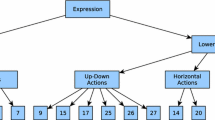Abstract
Humans have abstract models for object classes which helps recognize previously unseen instances, despite large intra-class variations. Also objects are grouped into classes based on their purpose. Studies in cognitive science show that humans maintain abstractions and certain specific features from the instances they observe. In this paper, we address the challenging task of creating a system which can learn such canonical models in a uniform manner for different classes. Using just a few examples the system creates a canonical model (COMPAS) per class, which is used to recognize classes with large intra-class variation (chairs, benches, sofas all belong to sitting class). We propose a robust representation and automatic scheme for abstraction and generalization. We quantitatively demonstrate improved recognition and classification accuracy over state-of-art 3D shape matching/classification method and discuss advantages over rule based systems.
Access this chapter
Tax calculation will be finalised at checkout
Purchases are for personal use only
Preview
Unable to display preview. Download preview PDF.
Similar content being viewed by others
References
Winston, P.H.: Learning structural descriptions from examples. In: Winston, P.h. (ed.) The Psychology of Computer Vision, McGraw-Hill, New York (1975)
Winston, P., Binford, T., Katz, B., Lowry, M.: Learning physical descriptions from functional definitions, examples,and precedents. In: Proc. Int. Symp. Robotics Research, vol. 1. MIT Press, Cambridge (1984)
Connell, J.H., Brady, M.: Generating and generalizing models of visual objects. Artif. Intell. 31, 159–183 (1987)
Brady, M., Agre, P.E., Braunegg, D.J., Connell, J.H.: The mechanics mate. In: Advances in Artificial Intelligence, pp. 79–94 (1985)
Minsky, M.: The society of mind, pp. 79–94 (1985)
Posner, M.I., Keele, S.W.: On the genesis of abstract ideas. J. Exp. Psychol. 77, 353–363 (1968)
Reed, S.K.: Pattern recognition and categorization. Cognitive Psychology 3, 382–407 (1972)
Smith, J.D., Paul, J.: Distinguishing prototype-based and exemplar-based processes in dot-pattern category learning. Processes in Category Learning, Journal of Experimental Psychology: Learning, Memory, and Cognition, 800–811 (2002)
Stark, L., Bowyer, K.: Achieving generalized object recognition through reasoning about association of function to structure. IEEE Transactions on Pattern Analysis and Machine Intelligence 13, 1097–1104 (1991)
Stark, L., Bowyer, K.: Function-based generic recognition for multiple object categories. CVGIP: Image Understanding 59, 1–21 (1994)
Pechuk, M., Soldea, O., Rivlin, E.: Learning function-based object classification from 3d imagery. Computer Vision and Image Understanding 110, 173–191 (2008)
Fried, L.S., Holyoak, K.J.: Induction of category distributions: A framework for classification learning. Journal of Experimental Psychology: Learning, Memory, and Cognition 10, 234–257 (1984)
Rips, L.J.: Similarity, typicality, and categorization, pp. 21–59 (1989)
Estes, W.K.: Array models for category learning. Cognitive Psychology, 500–549 (1986)
Brooks, L.R.: Nonanalytic concept formation and memory for instances. In: Rosch, E., Lloyd, B.B. (eds.) Cognition and Categorization, pp. 169–211 (1978)
Rosch, E.: Principles of categorization. In: Rosch, E., Lloyd, B.B. (eds.) Cognition and Categorization, pp. 27–48 (1978)
Ashby, F.G., Alfonso-Reese, L.A., Turken, A.U., Waldron, E.M.: A neuropsychological theory of multiple systems in category learning. Psychological Review, 442–481 (1998)
Ashby, F.G., Ell, S.W.: The neurobiology of human category learning. Trends in Cognitive Science, 204–210 (2001)
Erickson, M.A., Kruschke, J.K.: Rules and exemplars in category learning. Journal of Experimental Psychology: General, 107–140 (1998)
Love, B.C., Medin, D.L., Gureckis, T.M.: A network model of category learning. Psychological Review, 309–332 (2004)
Vanpaemel, W., Storms, G.: In search of abstraction: the varying abstraction model of categorization. Psychonomic Bulletin and Review, 732–749 (2008)
Smith, J.D., Chapman, W.P., Redford, J.S.: Stages of category learning in monkeys (macaca mulatta) and humans (homo sapiens). Journal of Experimental Psychology: Animal Behavior Processes, 39–53 (2010)
Veloso, M.M., Rybski, P.E., von Hundelshausen, F.: Focus: a generalized method for object discovery for robots that observe and interact with humans. In: HRI 2006: Proceedings of the 1st ACM SIGCHI/SIGART Conference on Human-Robot Interaction, pp. 102–109. ACM, New York (2006)
Gupta, A., Kembhavi, A., Davis, L.S.: Observing human-object interactions: Using spatial and functional compatibility for recognition. IEEE Transactions on Pattern Analysis and Machine Intelligence 31, 1775–1789 (2009)
Biederman, I.: Recognition-by-components: A theory of human image understanding. Psychological Review 94, 115–147 (1987)
Shilane, P., Min, P., Kazhdan, M., Funkhouser, T.: The princeton shape benchmark. Shape Modeling International (June 2004)
Saupe, D., Vranic, D.V.: 3D model retrieval with spherical harmonics and moments. In: Radig, B., Florczyk, S. (eds.) DAGM 2001. LNCS, vol. 2191, pp. 392–397. Springer, Heidelberg (2001)
Kostelec, P.J., Rockmore, D.N.: Ffts on the rotation group. Technical report (2003)
Kostelec, P., Rockmore, D.: Ffts on the rotation group. Journal of Fourier Analysis and Applications 14, 145–179 (2008)
Breiman, L.: Random forests. Machine Learning, 5–32 (2001)
Princeton: 3d model search engine, http://shape.cs.princeton.edu/search.html
Winston, P.H.: Learning structural descriptions from examples (1970)
Author information
Authors and Affiliations
Editor information
Editors and Affiliations
Rights and permissions
Copyright information
© 2011 Springer-Verlag Berlin Heidelberg
About this paper
Cite this paper
Somanath, G., Kambhamettu, C. (2011). Abstraction and Generalization of 3D Structure for Recognition in Large Intra-Class Variation. In: Kimmel, R., Klette, R., Sugimoto, A. (eds) Computer Vision – ACCV 2010. ACCV 2010. Lecture Notes in Computer Science, vol 6494. Springer, Berlin, Heidelberg. https://doi.org/10.1007/978-3-642-19318-7_38
Download citation
DOI: https://doi.org/10.1007/978-3-642-19318-7_38
Publisher Name: Springer, Berlin, Heidelberg
Print ISBN: 978-3-642-19317-0
Online ISBN: 978-3-642-19318-7
eBook Packages: Computer ScienceComputer Science (R0)




